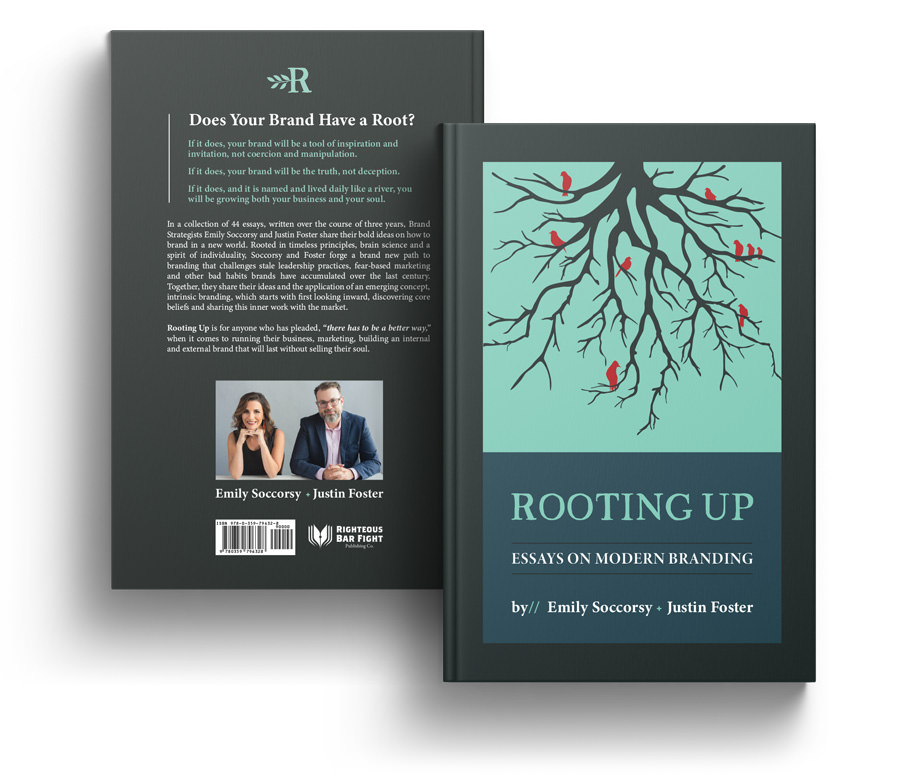Filed Under: 21st Century Branding, Beliefs-Based Branding, Intrinsic Branding, Leadership, Marketing, Social Media, Story, Team
By Emily Soccorsy and Justin Foster
One of the downsides of being an engaged leader in a company is that you really want the company to succeed.
You want the profitable business venture that leads to you and your team getting paid, furthering your cause, enjoying accomplishments to succeed. Badly, day-in and day-out. And as fast as possible.
You want it to succeed so much it creates other problems in the form of blindsides and subsequent quick fixes.
In the here-and-now, all that hyper-focused effort, nose to the grindstone, hustle, grind, is creating a series of short-sighted decisions crippling your future.
Your desire to see this venture succeed creates a blindside about the lifelong potential of the brand you are creating.
You think, “we have a logo, and it’s cool, so that’s our brand.”
Not even close.
You think, “Once we get bigger/more profitable, then we will invest in culture.”
Yikes.
You think, “after we have all the tanks topped off, we’ll stop the car and figure out where we’re going.”
Scary.
Once the faulty logic of these short-term success-focused decisions rear up, you will likely reach for quick fixes, ie hastily called meetings on company vision and mission statements, and racking your brains for catchy slogans that stand in for substantive brand messages. You might hire a marketing “guru” or redesign your logo figuring it will fix the issue fast. These approaches are Band-Aids for gunshots.
So how do you counteract that persistent drumbeat driving you toward success and blinding you to the vision you need to get there?
Steps to Gain Clarity on The Vision You Seek:
First, stop. Really. Just stop and sit for 10 minutes. Get out of shooting-the-rapids mode for a bit. Let the silt in your mind settle. Now, what does the future of your brand look like? Describe it out loud. Give it colors and structure and flavor. Use your imagination. What visuals come to mind? How do you feel about your future brand?
Second, consider this: how aligned is your current brand with your future brand? What’s missing? What current realities become obvious in light of your future brand? And are you a mission brand or an entity brand? If you’ve built an entity brand, your future brand will be an entity brand. That’s not a bad thing. But you will be beholden to shareholder value, market share, ROI and other entity brand metrics. If you launched this business as an extension of your personal mission, then the present and future state of the brand needs to be mission-centric. If you launched this business to change something you see as very wrong in your industry, your present and future brand needs to be addressing that the front.
Third, who are your inspiration points? Take a cue from producers and musicians who draw heavily from influencers who are predecessors — or contemporaries — in different genres. Bob Dylan was influenced by Chuck Berry and Little Richard. The Beatles were influenced by Buddy Holly and The Byrds. Lady Gaga was influenced by Madonna and David Bowie and Grace Jones. All still very distinct sounds on their own who drew inspiration from others. What brands inspire you to do what you do? What leader do you want to emulate? Why? As driven leaders, we far too often are stalled by our egos telling us we must do things on our own and without taking anything from others. That’s silliness. All of humanity’s creations are iterations on earlier or current versions.
Lastly, and most importantly, imagine a world where your brand has become dominant in your space. Don’t just read that sentence and charge on. Stop. Suspend your disbelief, and think about it. What might that world look like? What do you want your brand to be a symbol of? What dent do you want to make in the universe?
The Scoop on Visionaries and How They Can Inspire Your Brand:
While Apple lost its visionary-in-chief eight years ago, the company is still running — and innovating — on the vision Steve Jobs invented and shared relentlessly within his company. The same holds true for Herb Kelleher and Southwest, and for Walt Disney and the Disney empire. They call these founders “visionaries” for a reason. Each decision was aligned with the visionaries’ objectives to help the brand reach its highest future state. Each started out small, but their ideas weren’t small. And — this is vital — as they got big, they continued to innovate.
Bottom line: your brand today must be aligned with your future brand. And the only one who can get you there is you. Your success depends on it.
Emily Soccorsy + Justin Foster are cofounders of the intrinsic branding practice known as Root + River. Together with their defiantly different clients, they uncover then articulate the foundational elements of the brand. Then, they provide brand strategy and brand coaching as the brand is rolled out internally and externally. Obsessive about language and differentiation, Emily + Justin are also authors and speakers. Follow @rootandriver @fosterthinking and @emilyatlarge.
